As one of the earliest mediums in western art history, marble has been a dominant influence on artists for centuries. From the classical sculptures of ancient Greece to the marble halls of Art Deco buildings, this versatile material is known for its semi-opaque surface and long-lasting vibrancy.
 Above: marble sculptures from ancient Greece, ancient Rome, medieval Paris, renaissance Europe, and napoleonic Italy
Above: marble sculptures from ancient Greece, ancient Rome, medieval Paris, renaissance Europe, and napoleonic Italy
However, the bright surface of marble sculptures and decoration is one of the most frequent reasons for restoration. Staining and discolouration often bring this classical medium to our studio, disturbed by their environment, acidic adhesives or frequent skin contact. Marble may also shatter and break, requiring a sensitive conservation approach to restore the exquisite surface.
 Above: detail from a French marble relief depicting The Reign of Jupiter, 1550–70
Above: detail from a French marble relief depicting The Reign of Jupiter, 1550–70
This article will look into the ways marble can be appropriately cared for at home, as well as how it can be safely restored by our team of specialist conservators.
A brief history of marble sculpture
Some of the most celebrated artworks in the world are formed from marble, famously originating with the artefacts of ancient Greece and Rome. The word itself derives from the Greek ‘marmaíro’ meaning crystalline rock or shining stone. These sculptures have been so significant that they have dictated the ‘ideal’ physical proportions in art history for centuries.
 Above: ancient greek marble artefacts including a votive relief, fragment of a funerary naiskos, head of a Ptolemaic queen, funerary lekythos of Aristomache, head of a goddess, a bearded herm head, akroterion from a grave monument and stele (grave marker)
Above: ancient greek marble artefacts including a votive relief, fragment of a funerary naiskos, head of a Ptolemaic queen, funerary lekythos of Aristomache, head of a goddess, a bearded herm head, akroterion from a grave monument and stele (grave marker)
The island of Paros was a famous source for this material, referred to as Parian marble – a pure white, tightly grained rock with a semi-translucent surface. Sculptures such as the Winged Victory of Samothrace and Venus de Milo were composed from Parian marble, as well as the roof tiles of the Parthenon and the later statue of Augustus from Prima Porta.
 Above: examples of Parian marble from the Archaic period (525 BC) and Late Hellenistic period (1st century BC)
Above: examples of Parian marble from the Archaic period (525 BC) and Late Hellenistic period (1st century BC)
However, not all ancient civilisations would have viewed this natural composition. In recent years, it has been established that many Grecian and Roman sculptures were painted with bright pigments – giving them a much different effect to the bright mineral we see today. This knowledge has changed the way modern art historians talk about marble works, but in the past the bright white surfaces fed into the idea of the perfect male and female forms. Having a pale complexion reminiscent of classical marble was much sought after – even if this deeply pallid appearance was often caused by ailments such as tuberculosis.
 Above: roman marble depicting idealised male and female forms inclding a statue of Aphrodite (100-300 AD), a fragment of a member of the imperial family (27 BC – 68 AD), The Three Graces (100-200 AD), head of a youth (117-161 AD) and a roman copy of The Doryphoros (27 BC – 68 AD)
Above: roman marble depicting idealised male and female forms inclding a statue of Aphrodite (100-300 AD), a fragment of a member of the imperial family (27 BC – 68 AD), The Three Graces (100-200 AD), head of a youth (117-161 AD) and a roman copy of The Doryphoros (27 BC – 68 AD)
Although examples can be found throughout the mediaeval period, it was during the renaissance that marble sculpture had a true resurrection in form. The ethereal glow of the medium was perfect for the depiction of holy figures in the Christian world and by the late 15th century it was a popular in both religious and secular settings as a highly respected genre.
 Above: marble sculptures from the 15th century including Saint Andrew by Andrea Bregno (1491), bust of a boy attributed to Gian Cristoforo Romano (late 15th/early 16th century), a Virgin and Child from North Italy (1425), the Christ Child attributed to Michele di Luca Marini (1490s) and Young Warrior by Tullio Lombardo (1490s)
Above: marble sculptures from the 15th century including Saint Andrew by Andrea Bregno (1491), bust of a boy attributed to Gian Cristoforo Romano (late 15th/early 16th century), a Virgin and Child from North Italy (1425), the Christ Child attributed to Michele di Luca Marini (1490s) and Young Warrior by Tullio Lombardo (1490s)
Michelangelo’s Pietà is the only work to have ever been signed by the artist and is inscribed ‘MICHÆLANGELVS BONAROTVS FLORENTINVS FACIEBAT’ translated as Michelangelo Buonarroti, the Florentine made this. The Pietà is seen as a vital work in the development of the High Renaissance period, after it was severely damaged in 1972 the broken pieces were restored back into place – missing parts, including the Virgin’s nose, were recreated by using marble from the back of the sculpture.
 Above: a marble sculpture of Saint Margaret by renaissance sculptor Antonello Gaggini (said to have been an assistant to Michelangelo) 1520–1530
Above: a marble sculpture of Saint Margaret by renaissance sculptor Antonello Gaggini (said to have been an assistant to Michelangelo) 1520–1530
Fashionable classical ideals and theories saw an enthusiastic revival of marble statuary in the 17th and 18th centuries. Grand Tourists would travel to Italy and Greece in search of sculptural artefacts, either to form part of their studies or to collect and bring home to Britain. You can find out more about this period in our article on The Grand Tour here. The study of classical sculptures was an important part of an artist’s training, leading many of the Old Masters to continue using ancient compositions of bodies, perspective and tone.
 Above: Madame de Wailly by Augustin Pajou (1789), Andromeda and the Sea Monster by Domenico Guidi (1694), funerary monument for the Marquis de Tourney by François-Nicolas Delaistre (1787-93) and Sleeping Endymion by Agostino Cornacchini (1716)
Above: Madame de Wailly by Augustin Pajou (1789), Andromeda and the Sea Monster by Domenico Guidi (1694), funerary monument for the Marquis de Tourney by François-Nicolas Delaistre (1787-93) and Sleeping Endymion by Agostino Cornacchini (1716)
By the Regency era, neoclassicism was a well-established theme in country houses and palaces around Europe, as well as Federalist homes in the United States. Numerous copies of ancient sculptures were commissioned for landscape gardens; figures of Diana, Apollo, Bacchus and other ancient deities were popular. These sculptures not only gave reference to their owner’s high education, but could also enhance the attributes of their family and estate through their allegories.
 Above: detail of Perseus with the Head of Medusa by Antonio Canova, 1804-6
Above: detail of Perseus with the Head of Medusa by Antonio Canova, 1804-6
Sculptures such as portrait busts and funerary monuments were also being commissioned by wealthy patrons from the baroque period through to the late 19th century. Marble continued to be used as an authoritative medium to portray a true sense of imperial power; the memorial to Queen Victoria outside Buckingham Palace is composed from Pentelic marble from Attica, an ancient material that can be found on the Acropolis. Similarly, the tomb of Napoleon is crafted from the same Parian marble used in classical statuary.
 Above: George Washington by Horatio Greenough (1832), Rachel Fanny Antonina Le Despencer by John Bacon the Younger (1820), Napoleon after a model by Antonio Canova (1808-14) and a personification of America by Hiram Powers (1854)
Above: George Washington by Horatio Greenough (1832), Rachel Fanny Antonina Le Despencer by John Bacon the Younger (1820), Napoleon after a model by Antonio Canova (1808-14) and a personification of America by Hiram Powers (1854)
By the turn of the 20th century, marble was being used in combination with other materials such as bronze and enamel. Polychrome sculptures of the late 19th and early 20th century are often reminiscent of chryselephantine statuary, substituting ivory for stone. The chryselephantine appearance was especially popular during the Art Nouveau movement. Interior and exterior marble plaques and sculptural work can also be found throughout key examples of Art Deco design.
 Above: two busts by Charles-Henri-Joseph Cordier (1860s) and Madame X by Rodin (1907)
Above: two busts by Charles-Henri-Joseph Cordier (1860s) and Madame X by Rodin (1907)
Sculpture care and restoration
Most sculptures are housed indoors to avoid the dangers of open air display. Although antique marble has survived for centuries outside, it should be kept in mind that they have usually been in much warmer climates than we experience in the UK. As well as wearing down in the wet weather, open air sculptures may discolour due to pollution, be contaminated by acidic animal droppings, or be susceptible to accidental damage during garden maintenance.
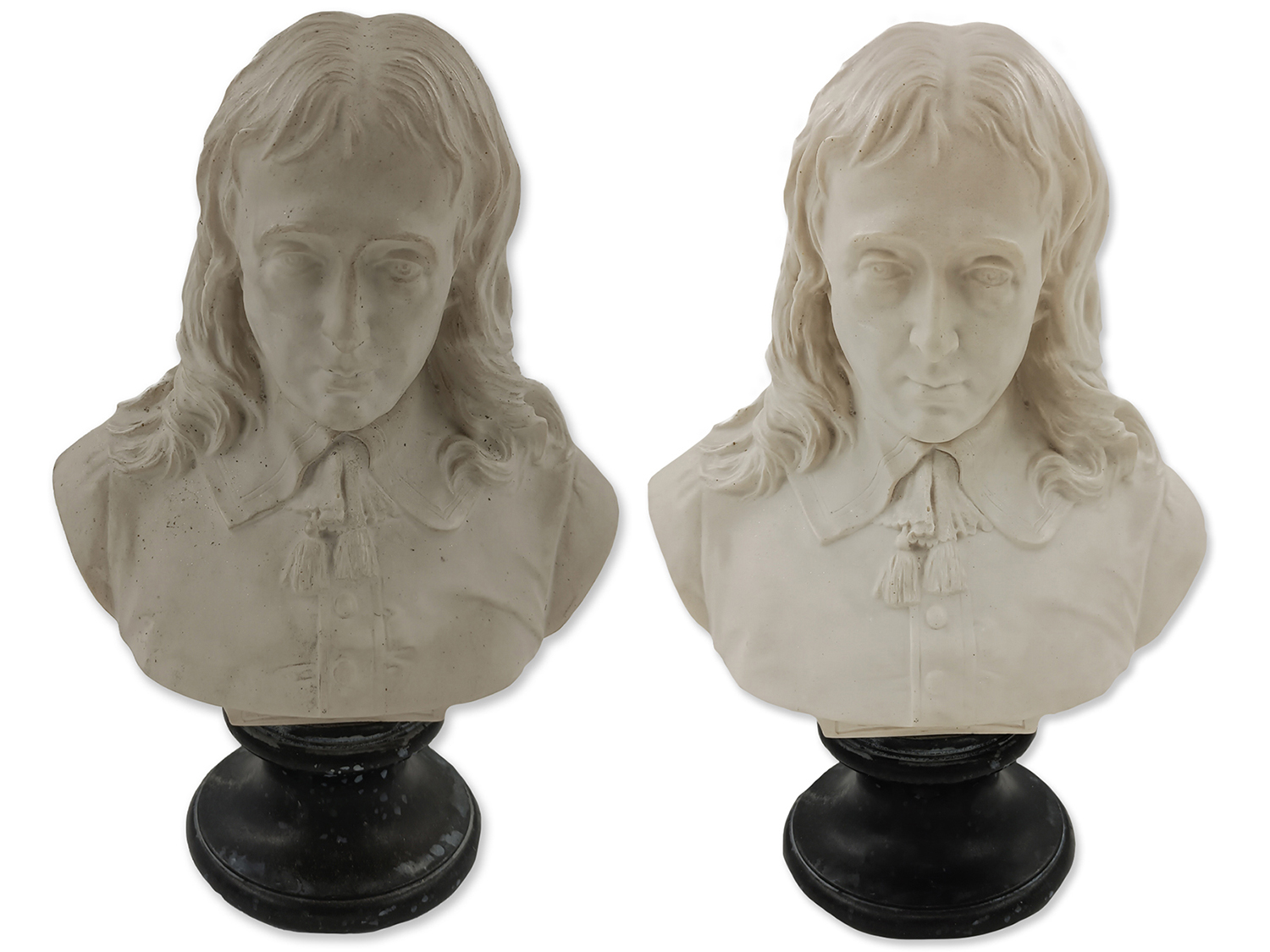
A particularly valuable or vulnerable marble sculpture should be sheltered, if this is not possible we suggest routine condition assessments to ensure any evidence of deterioration is halted before it worsens. You can find out more about the care of open air sculptures here.
A major issue facing external stone sculptures is soluble salts. This is primarily caused by the continuous drenching of rainwater and drying process which occurs. Pores hold water inside small cavities, creating a perfect location for salt crystals to eventually form. Soluble salts may lay dormant for many years before they become visually obvious. When the salt crystals erupt, drastic disturbances and breakages to the surface will occur and fast accelerate the decay of the sculpture.
 Above: the reversal of old repairs is often the reason for ceramic sculpture restoration – above you can see how household glue can yellow and cause acidic deterioration, this can be reversed by our conservator for a safe and clear finish
Above: the reversal of old repairs is often the reason for ceramic sculpture restoration – above you can see how household glue can yellow and cause acidic deterioration, this can be reversed by our conservator for a safe and clear finish
Marble items near a door or window may be affected by changes in temperature as well as external pollutants entering the room. Indoors, discolouration can also occur due to open fireplaces, nicotine, and frequent skin contact. Displaying your bust in a clean and stable environment is highly recommended.
Frequent touching of marble statuary is a common problem in public spaces, oils in the skin can easily transfer and blemish a bright marble surface. The external features will become smoothed down, losing vital details. If you notice this occurring, consider placing the bust further away from the reach of curious hands or placing a polite sign nearby advising visitors not to touch.
 Above: two statues that have been exposed to city pollution in New York
Above: two statues that have been exposed to city pollution in New York
Throughout history, the constant application of wax and buffering of surfaces during routine cleaning has softened what were once precisely carved areas. Marble sculptures should not be cleaned regularly, only a very light dusting is recommended. Constant cleaning may abrade the surface, distorting the fine details of the face and drapery. Avoid the use of any cleaning products, as acidic or alkali liquids may cause irreparable harm.
If your bust has been caught in a disaster such as a fire or flood, professional cleaning is required. If a bust becomes stained, do not try to remove it with household cleaning products. Rubbing the area may cause the stain to become worse. Leave the stain to dry and get in touch with our team, our conservators will use specialist techniques to draw the stain out of the material.
 Above: ceramics of all varieties may deteriorate due to age and the conditions they have been preserved in
Above: ceramics of all varieties may deteriorate due to age and the conditions they have been preserved in
If you have a heavy marble sculpture positioned upon a plinth, ensure it is stable and unable to topple over. Wooden and stone plinths may deteriorate over time, leading to accidental damage and severe breakages. If you are unsure about the condition of the plinth or need a replica to be created, speak to our helpful team for advice and guidance.
Our ceramics conservator is able to restore a wide range of decorative materials, including marble. This type of restoration usually occurs following discolouration or accidental breakages, as well as the reversal of old repairs that have aged badly. For more information, please get in touch via the contact form below.
How can we help?
If you have any questions about restoration, please do not hesitate to get in touch. As part of our service we offer a nationwide collection and delivery service. E-mail us via [email protected] or call 0207 112 7576 for more information.

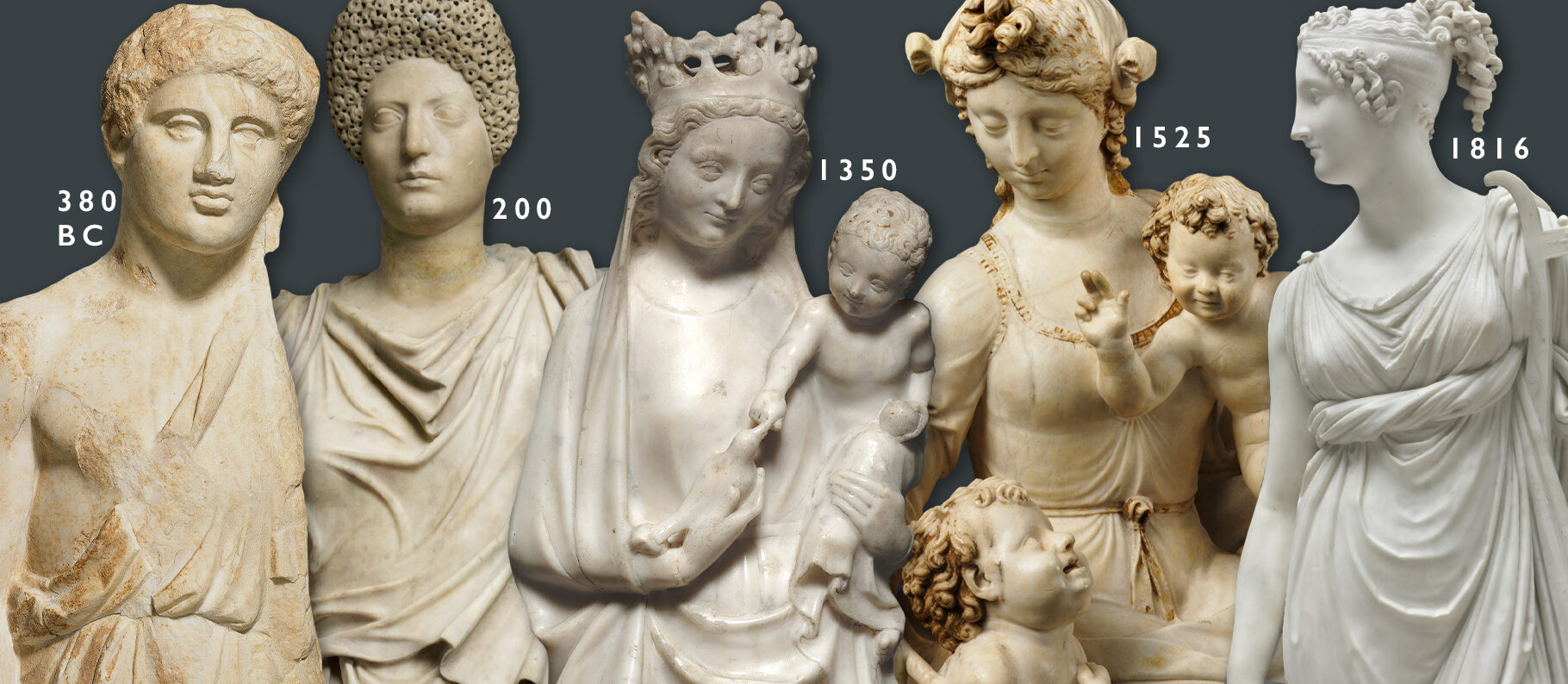 Above: marble sculptures from ancient Greece, ancient Rome, medieval Paris, renaissance Europe, and napoleonic Italy
Above: marble sculptures from ancient Greece, ancient Rome, medieval Paris, renaissance Europe, and napoleonic Italy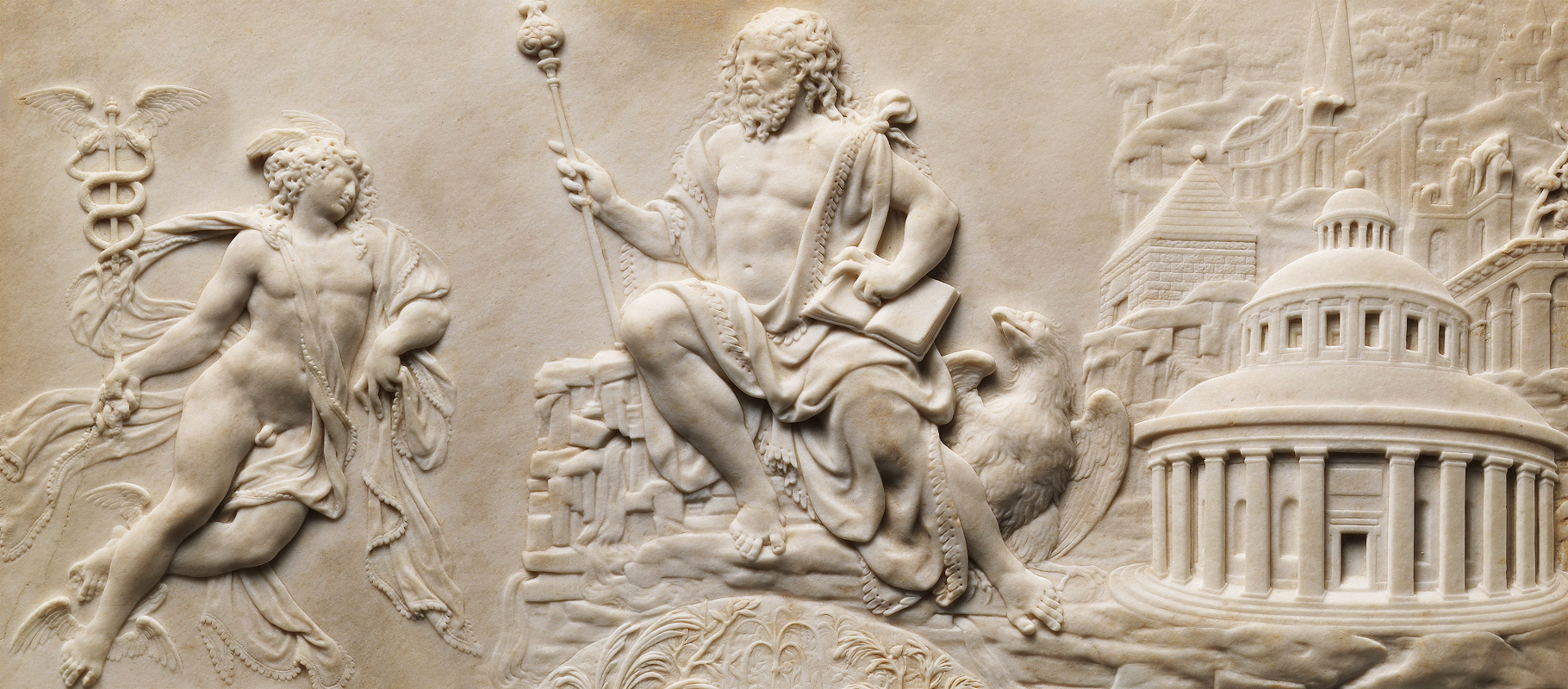 Above: detail from a French marble relief depicting The Reign of Jupiter, 1550–70
Above: detail from a French marble relief depicting The Reign of Jupiter, 1550–70 Above: ancient greek marble artefacts including a votive relief, fragment of a funerary naiskos, head of a Ptolemaic queen, funerary lekythos of Aristomache, head of a goddess, a bearded herm head, akroterion from a grave monument and stele (grave marker)
Above: ancient greek marble artefacts including a votive relief, fragment of a funerary naiskos, head of a Ptolemaic queen, funerary lekythos of Aristomache, head of a goddess, a bearded herm head, akroterion from a grave monument and stele (grave marker) Above: examples of Parian marble from the Archaic period (525 BC) and Late Hellenistic period (1st century BC)
Above: examples of Parian marble from the Archaic period (525 BC) and Late Hellenistic period (1st century BC) Above: roman marble depicting idealised male and female forms inclding a statue of Aphrodite (100-300 AD), a fragment of a member of the imperial family (27 BC – 68 AD), The Three Graces (100-200 AD), head of a youth (117-161 AD) and a roman copy of The Doryphoros (27 BC – 68 AD)
Above: roman marble depicting idealised male and female forms inclding a statue of Aphrodite (100-300 AD), a fragment of a member of the imperial family (27 BC – 68 AD), The Three Graces (100-200 AD), head of a youth (117-161 AD) and a roman copy of The Doryphoros (27 BC – 68 AD)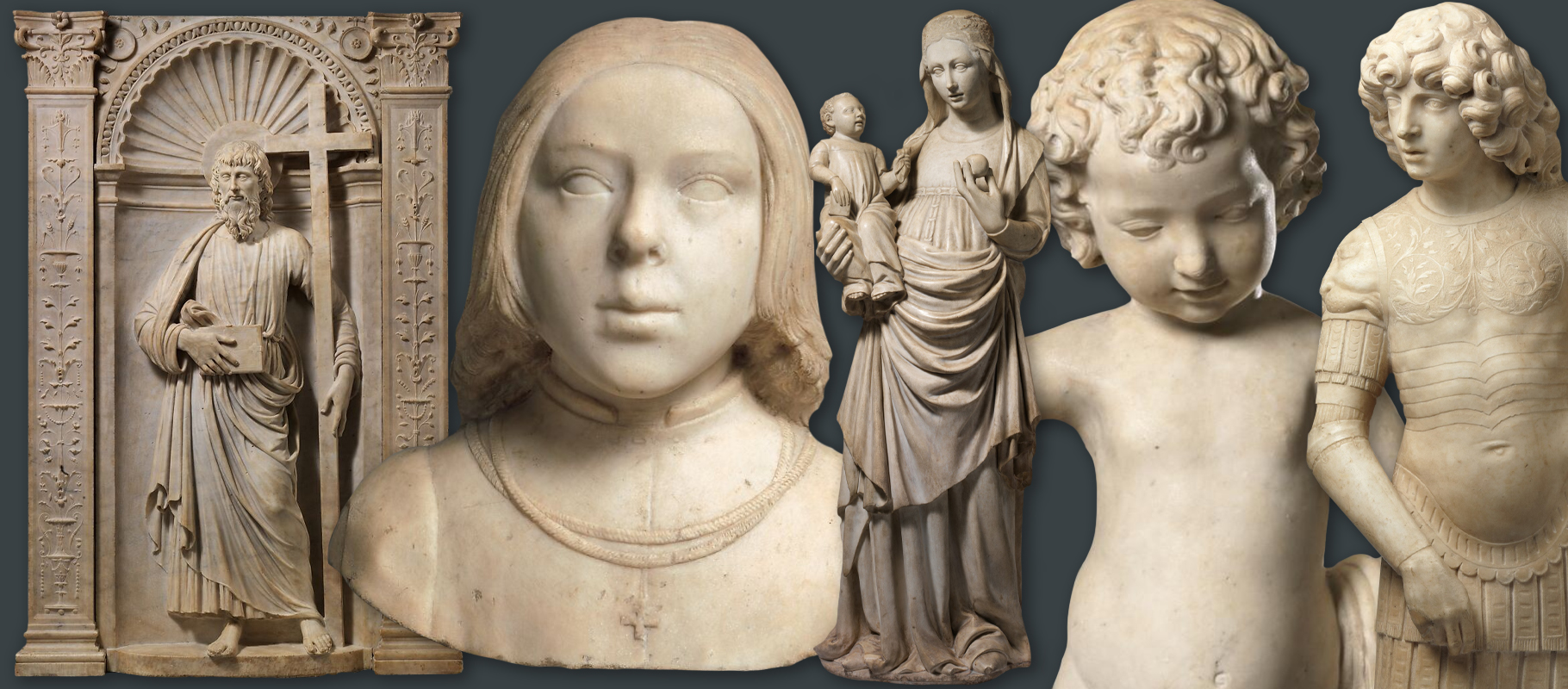 Above: marble sculptures from the 15th century including Saint Andrew by Andrea Bregno (1491), bust of a boy attributed to Gian Cristoforo Romano (late 15th/early 16th century), a Virgin and Child from North Italy (1425), the Christ Child attributed to Michele di Luca Marini (1490s) and Young Warrior by Tullio Lombardo (1490s)
Above: marble sculptures from the 15th century including Saint Andrew by Andrea Bregno (1491), bust of a boy attributed to Gian Cristoforo Romano (late 15th/early 16th century), a Virgin and Child from North Italy (1425), the Christ Child attributed to Michele di Luca Marini (1490s) and Young Warrior by Tullio Lombardo (1490s)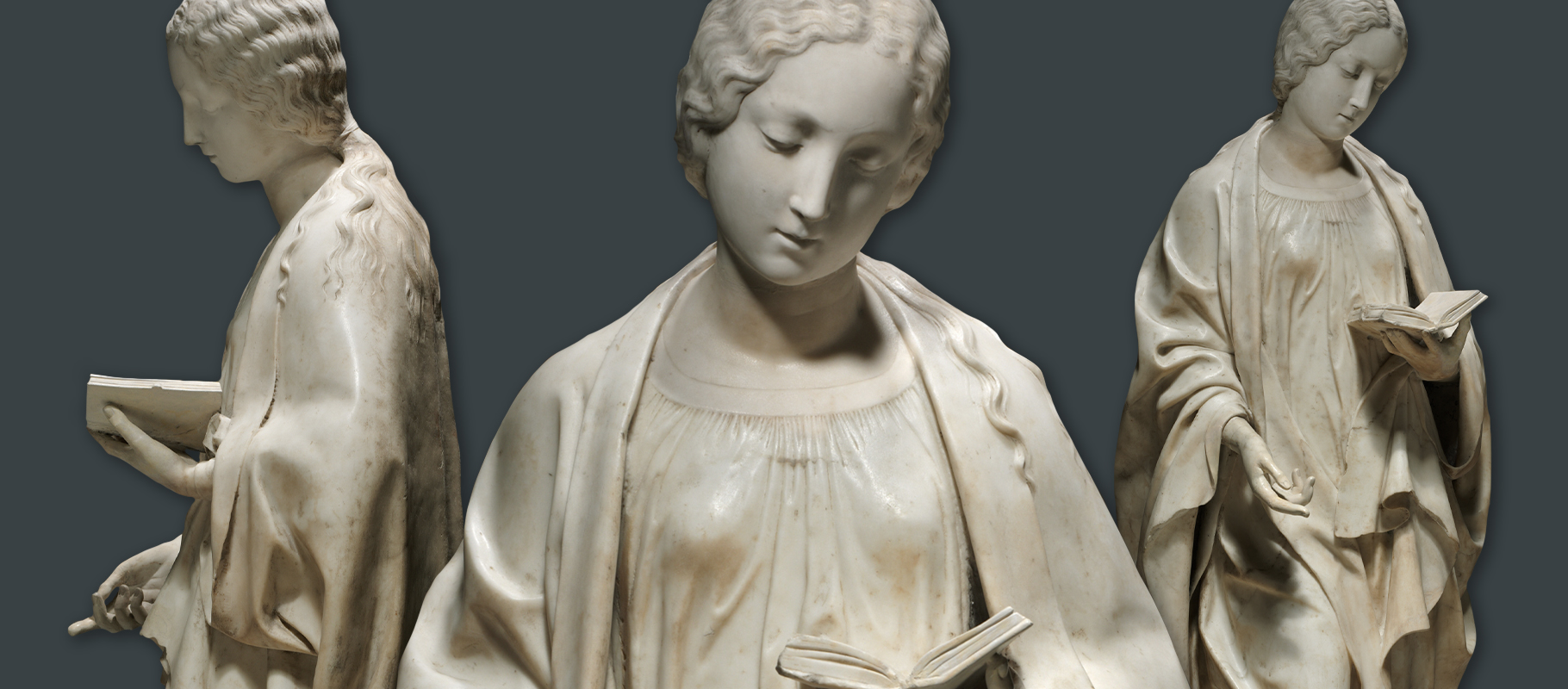 Above: a marble sculpture of Saint Margaret by renaissance sculptor Antonello Gaggini (said to have been an assistant to Michelangelo) 1520–1530
Above: a marble sculpture of Saint Margaret by renaissance sculptor Antonello Gaggini (said to have been an assistant to Michelangelo) 1520–1530 Above: Madame de Wailly by Augustin Pajou (1789), Andromeda and the Sea Monster by Domenico Guidi (1694), funerary monument for the Marquis de Tourney by François-Nicolas Delaistre (1787-93) and Sleeping Endymion by Agostino Cornacchini (1716)
Above: Madame de Wailly by Augustin Pajou (1789), Andromeda and the Sea Monster by Domenico Guidi (1694), funerary monument for the Marquis de Tourney by François-Nicolas Delaistre (1787-93) and Sleeping Endymion by Agostino Cornacchini (1716)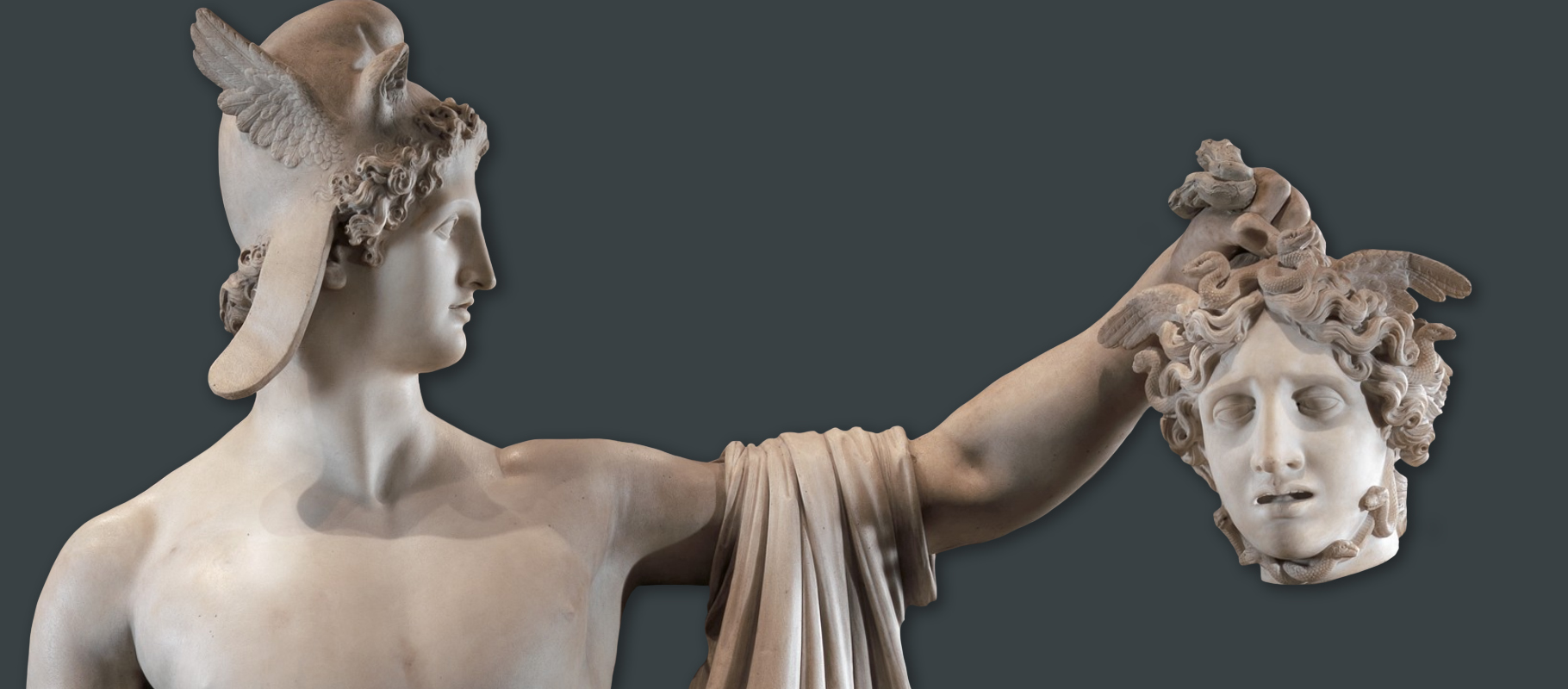 Above: detail of Perseus with the Head of Medusa by Antonio Canova, 1804-6
Above: detail of Perseus with the Head of Medusa by Antonio Canova, 1804-6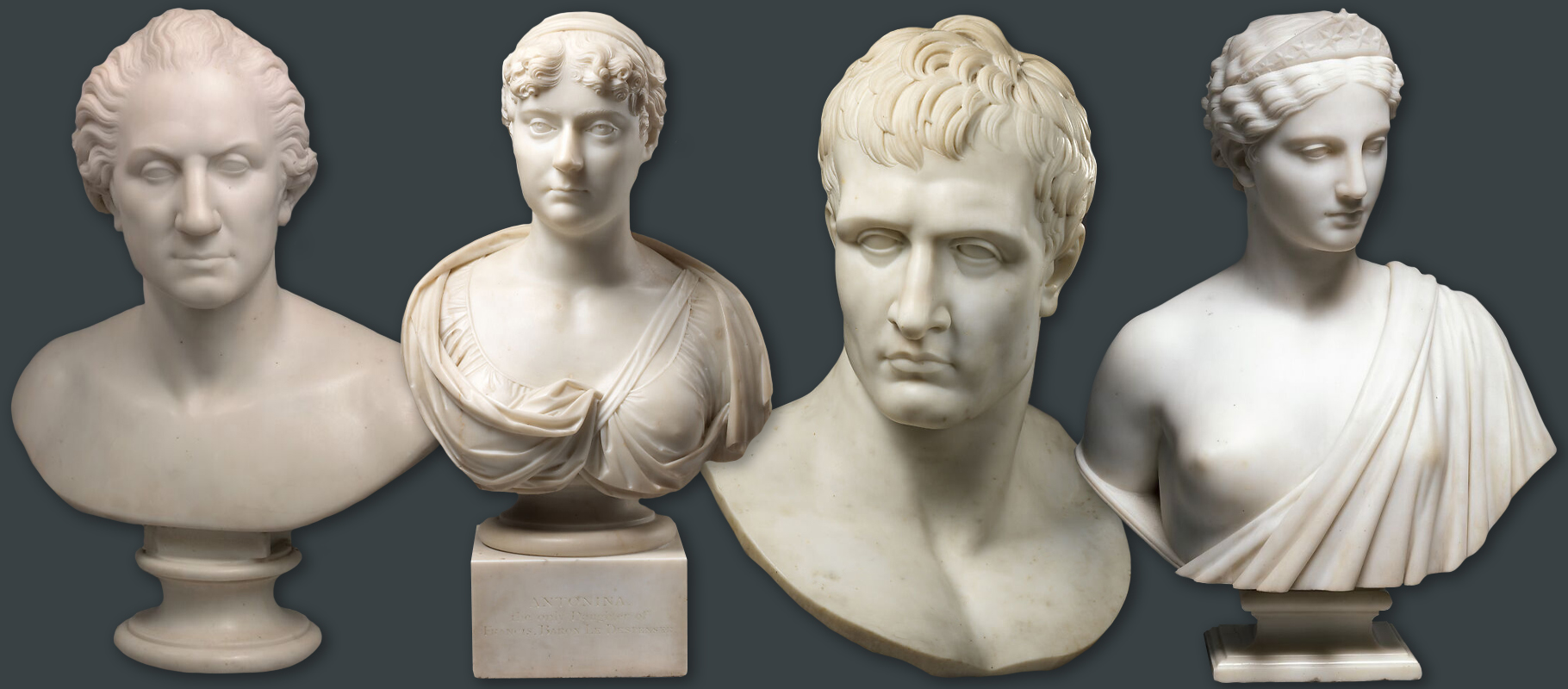 Above: George Washington by Horatio Greenough (1832), Rachel Fanny Antonina Le Despencer by John Bacon the Younger (1820), Napoleon after a model by Antonio Canova (1808-14) and a personification of America by Hiram Powers (1854)
Above: George Washington by Horatio Greenough (1832), Rachel Fanny Antonina Le Despencer by John Bacon the Younger (1820), Napoleon after a model by Antonio Canova (1808-14) and a personification of America by Hiram Powers (1854) Above: two busts by Charles-Henri-Joseph Cordier (1860s) and Madame X by Rodin (1907)
Above: two busts by Charles-Henri-Joseph Cordier (1860s) and Madame X by Rodin (1907)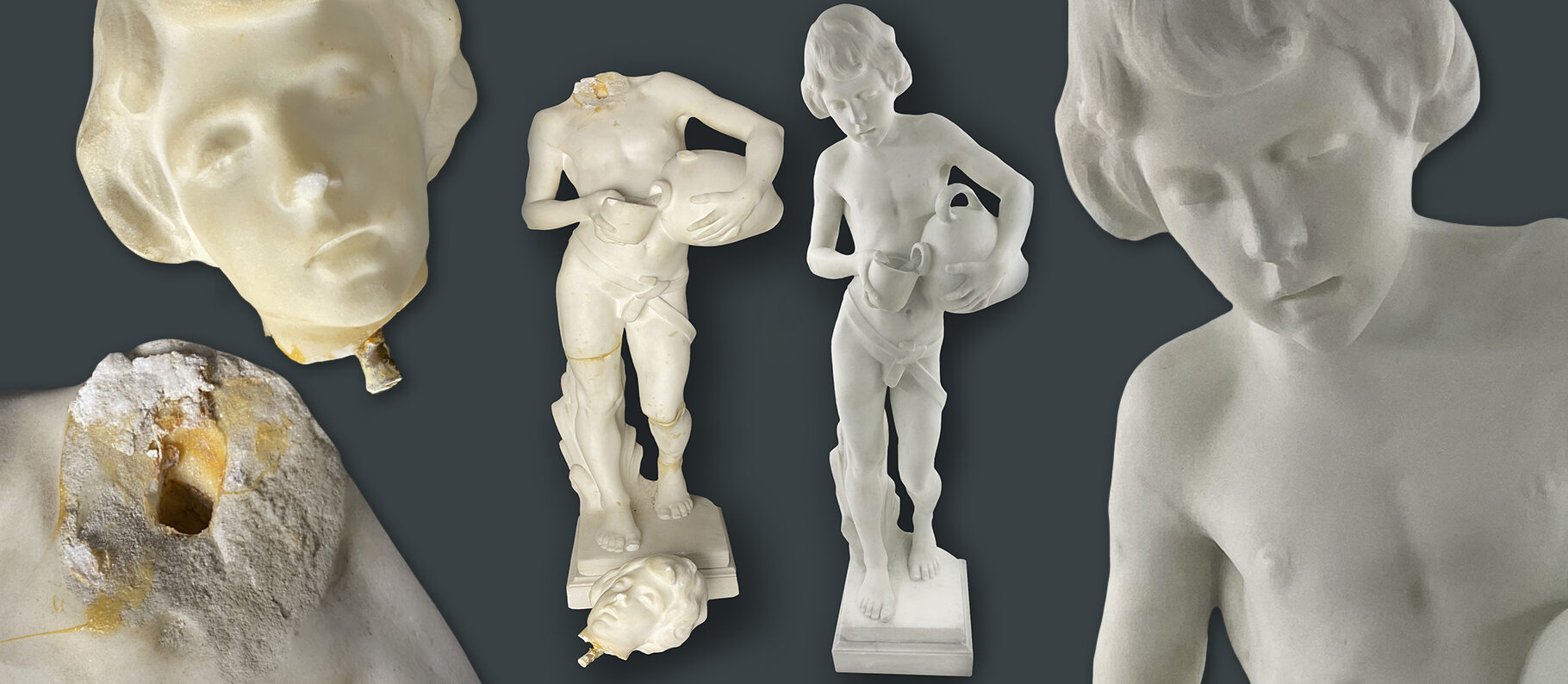 Above: the reversal of old repairs is often the reason for ceramic sculpture restoration – above you can see how household glue can yellow and cause acidic deterioration, this can be reversed by our conservator for a safe and clear finish
Above: the reversal of old repairs is often the reason for ceramic sculpture restoration – above you can see how household glue can yellow and cause acidic deterioration, this can be reversed by our conservator for a safe and clear finish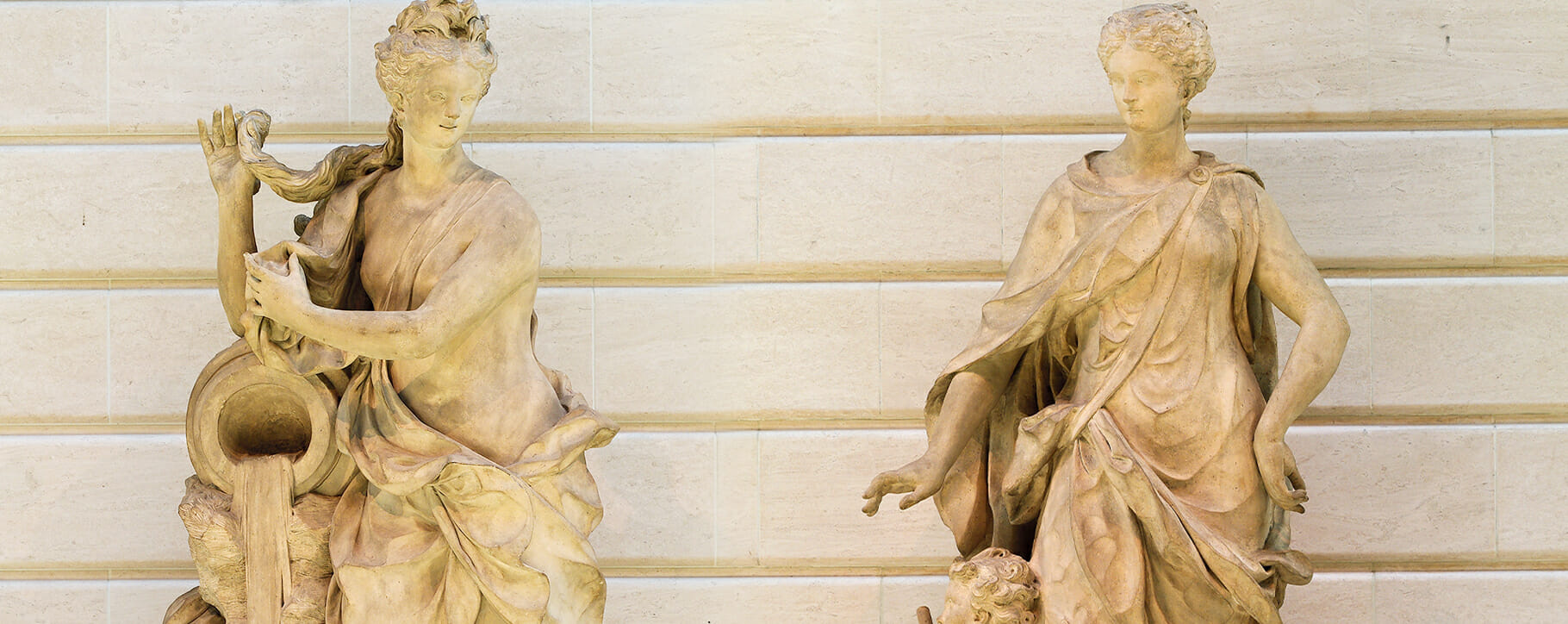 Above: two statues that have been exposed to city pollution in New York
Above: two statues that have been exposed to city pollution in New York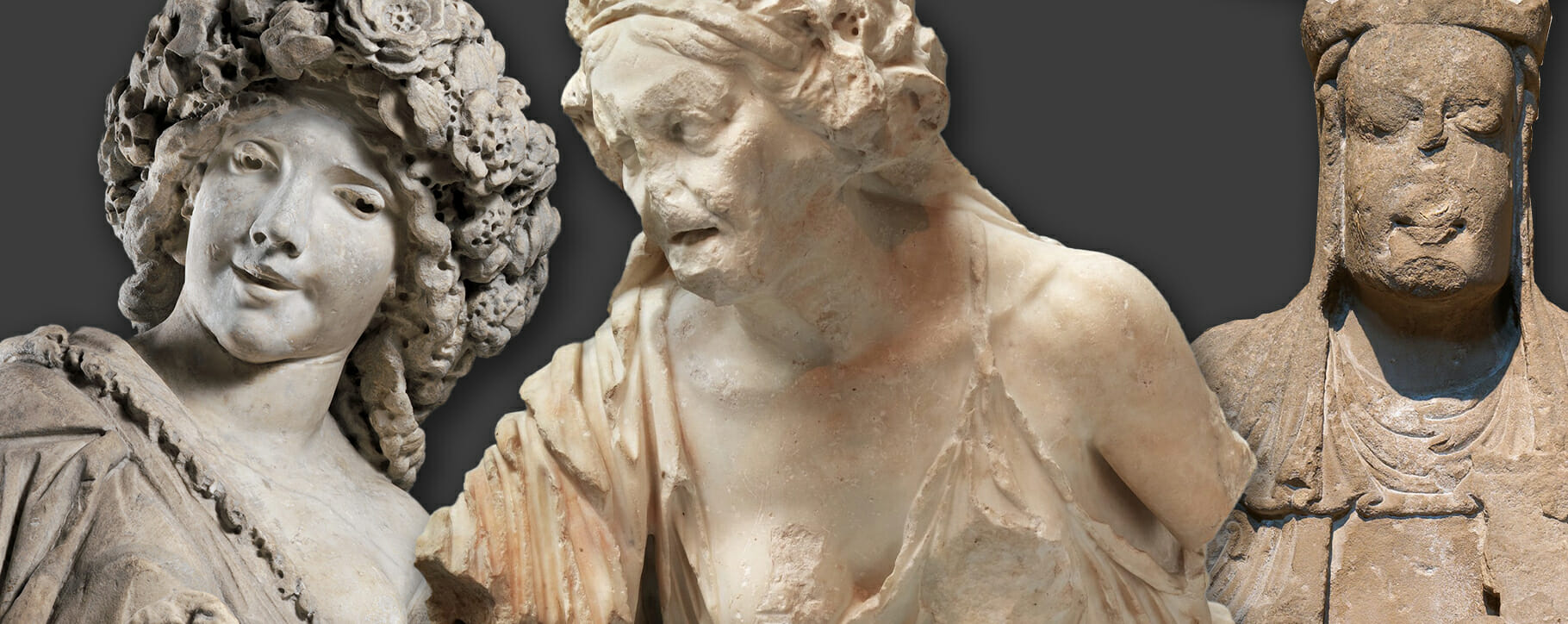 Above: ceramics of all varieties may deteriorate due to age and the conditions they have been preserved in
Above: ceramics of all varieties may deteriorate due to age and the conditions they have been preserved in




